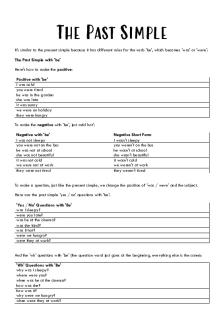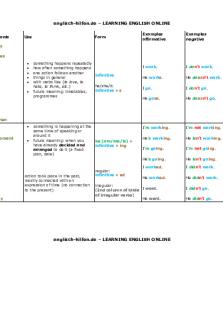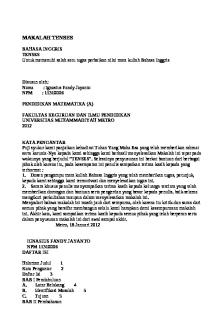Perfect Tenses PDF

| Title | Perfect Tenses |
|---|---|
| Author | Paulo Claudio |
| Course | Língua Inglesa |
| Institution | Universidade Cidade de São Paulo |
| Pages | 2 |
| File Size | 39.2 KB |
| File Type | |
| Total Downloads | 64 |
| Total Views | 175 |
Summary
Regras para o uso do tempo perfeito na língua inglesa. Professora Sandra ...
Description
PERFECT TENSES PRESENT PERFECT Have/has + past participle do verbo principal Usamos em -Ações indefinidas no passado Ex: We have finished our homework. Jane has traveled to London. They have accepted the job offer. *ATENÇÃO: Não confunda o PRESENT PERFECT com o SIMPLE PAST Ex: SIMPLE PAST PRESENT PERFECT Paul has lost his keys yesterday. Paul has lost his keys. My brother called me two days ago. My brother has called me. She left last week. She has left. -Com os advérbios “ever”, “never”, “already”, “yet”, “just”, “so far”, “lately”, “recently” e expressões como “once”, “twice”, “many times”, “few times”, etc. Ex: Have you ever seen a flying-saucer? She has never been to Rome. The ball hasn’t rung yet. Our cousins have just arrived. She has traveled a lot lately. Have you seen any good film recently? I have flown on na airplane many times. -Com “since” (=desde) e “for” (=há, faz) Ex:She has lived in New York since 1993. She has lived in New York for ten years. They have been apart since January. They have been apart for three months.
PRESENT PERFECT CONTINUOUS Have/ has + been + “-ing” do verbo principal Usamos em ações que se iniciaram no passado e continuaram até o momento presente. É frequentemente usado com “the whole morning” (day, week, etc), “since” e “for”. Ex: They have been looking for a job the whole month. They have been looking for a job since October. They have been looking for a jobe for six months. It has been raining the whole morning. It has been raining since 7 o’clock. It has been raining for three months. *OBSERVAÇÃO: com certos verbos, há pouca ou nenhuma diferença entre o Past Perfect e o Past Perfect Continuous....
Similar Free PDFs

Perfect Tenses
- 2 Pages

Narrative Tenses
- 8 Pages

Past tenses
- 2 Pages

Tenses Table
- 5 Pages

VERB TENSES
- 200 Pages

makalah tenses
- 12 Pages

Engels tenses herhalen
- 2 Pages

Verb Tenses Review
- 1 Pages

Narrative Tenses - majadhikfshai
- 1 Pages

RUMUS 16 TENSES
- 3 Pages

Mixed tenses 1
- 1 Pages
Popular Institutions
- Tinajero National High School - Annex
- Politeknik Caltex Riau
- Yokohama City University
- SGT University
- University of Al-Qadisiyah
- Divine Word College of Vigan
- Techniek College Rotterdam
- Universidade de Santiago
- Universiti Teknologi MARA Cawangan Johor Kampus Pasir Gudang
- Poltekkes Kemenkes Yogyakarta
- Baguio City National High School
- Colegio san marcos
- preparatoria uno
- Centro de Bachillerato Tecnológico Industrial y de Servicios No. 107
- Dalian Maritime University
- Quang Trung Secondary School
- Colegio Tecnológico en Informática
- Corporación Regional de Educación Superior
- Grupo CEDVA
- Dar Al Uloom University
- Centro de Estudios Preuniversitarios de la Universidad Nacional de Ingeniería
- 上智大学
- Aakash International School, Nuna Majara
- San Felipe Neri Catholic School
- Kang Chiao International School - New Taipei City
- Misamis Occidental National High School
- Institución Educativa Escuela Normal Juan Ladrilleros
- Kolehiyo ng Pantukan
- Batanes State College
- Instituto Continental
- Sekolah Menengah Kejuruan Kesehatan Kaltara (Tarakan)
- Colegio de La Inmaculada Concepcion - Cebu




